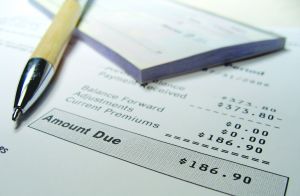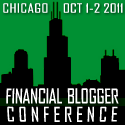When I was broke, overdraft fees were my biggest nemesis. No matter how careful I thought I was being, I paid at least $200 a month to the bank simply because I spent money that wasn’t there. I can’t even count the number of times I called my parents saying, “I need to put $60 in the bank or a check’s going to bounce!” or “I need gas and there’s only $2 in my account!”
I remember thinking, If I just had an extra hundred dollars a payday, I’d be able to make it through. Which was actually true, except I was looking at it backwards. If I had an extra hundred dollars, I could have gotten rid of the overdraft fees myself instead of borrowing from my mom and dad. But it wouldn’t have done a darn thing to help me stop overdrawing my bank account in the first place.
Why Overdrafts Happen
Simply put, overdrafts happen when you spend more money than you’ve got in the bank. This could happen because of an error (like the time I added the amount of a large check in my register instead of subtracting it), but more often, overdrafts happen because we don’t keep track of our spending.
Yep, I said it. If you are reading this and battling overdraft fees, you probably have no idea what you spend in a month. Don’t feel bad, because I didn’t either. I thought I knew - after all, I had a list of my bills and I knew what I paid with each paycheck - but I wasn’t even looking at what I spent other than those expected costs.
I actually didn’t have overdraft “protection” on my bank account. I opted out because I knew I’d take advantage of it. But when I had several checks come through at one time, or multiple charges over a weekend, my account would end up in the red. It used to drive me INSANE - I would be short a couple of dollars, so the bank would bounce a check. $32 fee. Then I would run up to the bank, deposit money, and they’d run it again. $32 fee for putting it through. Then everything else was off track, and I’d end up back in the red because I was missing $64. Sound familiar?
How to Stop the Cycle
Stopping the overdraft madness really sucks. You have to suffer for awhile, but it can be done.
My advice is a little different than what you’ll find elsewhere on the internet. I’m not saying I’m smarter than people like Gail Vaz-Oxlade, who posted about getting rid of overdrafts on her own blog. I’m just speaking as a recovering spendaholic. The methods I read online didn’t work for me because I wasn’t disciplined enough to see them through.
The only way I could stop paying overdraft fees was to take control away from myself and place it in the hands of someone I trust. For me, it was my dad. I don’t know who it is for you, but don’t be afraid to ask for help. You need it if you’re ever going to get out of the mess you’re in.
The (Painful) Steps
1. Print out at least three months of bank statements. Go through each of them with different colored pens or highlighters - one for bills, gas, groceries, restaurants, medical, and whatever other categories you spend in. Add up the totals for each category per month.
2. Grab your trusted friend/relative and give them your debit card. Sit down with your new personal banker and go over your plan. They may be able to point out something you haven’t thought of yet. They will also be taking on a huge role in getting your money under control. You’ll get the debit card back eventually. This person’s job is to (temporarily) manage your money and help you build a buffer against future overdrafts.
3. Get your bank account in the black. I don’t care if you sell something at a pawn shop or borrow from a friend, you’ve got to get your account to zero. And you can’t do it out of your paychecks because it’ll mess you up and you’ll overdraw again. Once you’ve done this, pat yourself on the back because you aren’t going to do it anymore.
4. STOP WRITING CHECKS. I was very dependent on checks because I could buy groceries or gas the day before payday. I knew which stores didn’t process the checks electronically, giving me a buffer of 24-48 hours. But sometimes I wrote a check and forgot about it, resulting in an overdraft fee. For this to work, you’ve got to stop writing checks completely. The last thing you need is that $50 check to Aunt Sophie messing you up.
5. Determine how much you need for bills ONLY. I’m talking about your rent or mortgage, car payments, utility bills, phone bill…. The stuff you pay every single month to keep your household running. If you have expenses that change from month to month (mine were utility bills), call the company to see if you can get on a plan that will make the payment the same each month.
6. Compare your remaining money to what you’ve been spending. If you have $400 left over to last two weeks, you need to know how much of that you use for gas and groceries. Maybe there are other things you’ll need during that timeframe - prescription medicines, $10 for a charity event at work, lunch money for your kids. Get an idea of where the remaining money will be spent.
7. When you get paid, leave enough money in the bank to pay bills plus $25 extra. You should know this amount from step 3, so that’s how much needs to stay in the bank. We want a small buffer ($25 right now) just in case.
8. Write one check to your trusted person for the remainder of your paycheck. This friend or family member is now in charge of your weekly allowance. That’s right, your allowance. Because that’s what it takes right now. They will also be withholding a certain amount each payday to build a buffer.
9. You will receive enough money to pay for gas and groceries for the week. IN CASH. I hate cash. When I did this myself, I freaked out - “What if I have $75 and my groceries are $80?” And my dad said, “Then you’ll be putting something back.” If I ran out of money, I had to sell something to earn extra. If I didn’t have enough gas to go to work, I had to either miss work or convince someone to loan me money. Which I had to report to my dad, who took repayment out of my allowance for the next week. Didn’t take me long to figure out I didn’t want to spend more than I had.
10. After you’ve done this for a month or two, ask your friend to go with you to the bank. You’re going to open a savings account, deposit your buffer, and instruct your bank to link it to your checking account. Then you are going to FORGET ABOUT IT.
That’s great, but how does this actually work in real life?
This post is huge, so I’m going to leave you with the steps for now. Check back tomorrow for a better explanation of how this works and how it will prevent you from paying overdraft fees in the future.








